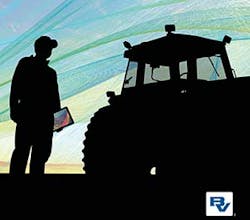Latest from FTTx/Optical Networks
Farmer-to-Everything Connections for the Future —
As high-tech city concepts gain momentum, like Bleutech Park Las Vegas (https://www.bleutechpark.com/), they become a beacon of our transforming world, a shining example of sustainable, smart living. But urban areas aren’t the only fertile grounds for data-driven initiatives.
Like US tech giants and entrepreneurs, farmers are futurists by nature: they plan for the next growing season, predict frost and storms, and forecast market sell targets. As part of their long-game, farmers deploy digital technologies such as sensors, machine learning and visioning, and artificial intelligence (AI), in their fields and facilities. These technologies help umpire animal behavior, crop yields, soil conditions, market pricing, and other unknowns, to optimize how farmers plan, produce, and bring food to market. A sustainable, high-yield approach to agriculture is critical because, by 2050, the global population will reach 9.8 billion, and food demand will increase by 50%.
InvisiLight® Solution for Deploying Fiber
April 2, 2022Go to Market Faster. Speed up Network Deployment
April 2, 2022Episode 10: Fiber Optic Closure Specs Explained…
April 1, 2022Food for Thought from Our 2022 ICT Visionaries
April 1, 2022Interest in tech-savvy farming is on the rise, but the rural Digital Divide is slowing agriculture modernization. As home-grown leaders, rural electric cooperatives (co-ops) may be the linchpin of closing the Digital Divide and building the networks to realize Agriculture 2.0 and our global food supply goals.
Farmer-to-Everything Connections
The Internet of Things (IoT) has made its way to America’s farms. From cropland and dairy barns to storage facilities, farmer-to-everything digital connections are putting the byte into food operations.
Digital apps, devices, and use cases, are evolving continually. Facial recognition software, for example, has evolved beyond its original use as a security tool. This evolution means that farmers will never look at cows the same way — literally. In the agricultural application, facial recognition software perceives patterns and shapes on each animals’ face and hide, giving them a digital identity. Cameras and AI track and monitor cow movement. This helps farmers understand individual feeding and watering habits, find lost cows, and discern illness or unusual behavior. As another device twist, Bluetooth-enabled health wearables — imagine a Bovine FitBit — monitor livestock health and reduce production costs, slashing medication per animal by 15%.
Interest in tech-savvy farming is on the rise, and communities need to assess fiber broadband infrastructure options and develop a plan for deployment.
In the air, drones hover above specialty and row crops. With US predicted market growth from $1.2 billion by 2019 to $4.8 billion by 2024, drones with thermal and spectral cameras produce low-altitude, high-resolution imagery that depicts farmland conditions beyond the naked eye. Farmers use drone data to spot pests, weeds, and irrigation issues, as well as to estimate crop yield, monitor livestock locations at night, and detect soil nutrient deficiencies. When paired with computer vision and machine learning, hyperspectral imaging can recognize food characteristics. What if tough steak and underripe fruit were a thing of the past? IoT technologies help farmers identify and cull low-quality products before they hit the grocery store.
The United States Department of Agriculture (USDA) estimates that if US agriculture realizes the full potential of digital technologies, then the industry would add $47-65 billion annually in additional gross income to the US economy. For the farmer, these technologies help balance their day-to-day issues such as worker shortages and the new complexities of climate change, which emphasize resource conservation. Connected technologies provide data-vision and fine-scale understanding of operations, which helps farmers identify precise, sustainable cultivation and management methods for their specific location, conditions, and production goals.
Incubator Farming
The future of farming is taking shape on a 40-acre plot near Fargo, North Dakota. The Grand Farm Initiative, spearheaded by Emerging Prairie, is a non-profit, collaborative test site that could give farming a techno-shot in the arm. With more than 200 experiments conducted in 2020, Grand Farm is a venue for experimentation and education centered on high-tech farming, such as autonomous farm vehicles and crop science.
Grand Farm’s incubator approach is not unlike other high-tech accelerators. It fosters collaboration and partnerships among farmers, businesses, higher education, and technology leaders, including Microsoft and North Dakota State University. These partnerships accelerate innovation that will kick-start technology growth and sustain farming into the future. Just as important, incubators help farmers climb the digital learning curve, which leads to faster technology adoption.
Technology testing grounds, like Grand Farm, help close the global food gap by developing sustainable production approaches that increase yield while conserving resources and reducing the need for pesticides and other chemicals. The USDA estimates that high-tech agriculture could reduce food insecurity by 7.5% in developing countries, cut fuel use by 40%, reduce water use by 20-50%, and slash chemical application by 80%.
Collaboration gets innovation flowing, but telecommunications — which enable sensors, IoT data, apps and digital technologies — transform ideas into field-deployed solutions. Wired and wireless networks are the gateways to the future of farming, and are essential to meet the world’s food and sustainability goals. But, the rural Digital Divide could cause agricultural innovation to lag.
The Rural Digital Divide
About 22% of rural communities do not have access to high-speed broadband, while many with service are plagued by inconsistent or slow connections. Broadband, enabled by fiber, is quickly becoming the chief indicator of which businesses stay competitive. It also makes farms more valuable and attracts younger digital natives to farming, which could slow generational decline and increase active farms.
It may be difficult to fathom dead zones in the US considering that fiber networks grew 17% in 2019 and now pass over 49 million homes. But, with a mix of urban and rural areas, most states contain digital haves and have-nots. Urban areas are wired, while fiber broadband in rural areas is unevenly applied.
By many accounts, fiber is the gold standard to enable broadband and support data-hungry apps and connected technologies that are pivotal to evolve agricultural innovation. While farmers use other broadband technologies — such as present-day satellite, mobile, dial-up, and Digital Subscriber Line (DSL) — these services have high-latency and/or low-bandwidth and are affected by weather, line-of-sight obstructions, and distance to towers or antennae.
Fiber sends large amounts of data securely over long distances with high reliability. With nearly unlimited data capacity, it supports a range of apps and technologies, and scales alongside future needs and capabilities, like 5G use cases. Once fiber is in place, the network can reach exponentially higher speeds with simple radio equipment additions.
What’s delaying fiber broadband in rural areas? Rural areas have low-density populations that are spread across expansive geographies. These conditions require significantly more miles of fiber to connect communities than urban or suburban settings where homes and businesses are tightly packed.
With fewer resident subscriptions to pay for service, the return on investment (ROI) period lengthens — or worse, cannot be realized. Often, these scenarios are non-starters for Internet service providers, but rural electric cooperatives (co-ops) are more flexible, making them ideal leaders for telecommunications deployment.
Rural Electric Cooperatives Lead
Rural electric co-ops have already deployed thousands of miles of fiber in rural districts — enough to account for 30% of rural fiber service. Co-ops may be the linchpin of closing the Digital Divide because they can deploy fiber successfully despite the challenging business model.
With agriculture innovation picking up speed, now is the right time for communities to assess fiber broadband infrastructure options and to develop a plan for deployment. Black & Veatch’s eBook, Rural Broadband – 8 Steps to Ensure Fiber Deployment Success, offers 8 steps, summarized here, to help deploy the critical communications networks.
8 Steps to Ensure Fiber Deployment Success (Summarized)
Step 1. Review Cost Assumptions and Business Plan
After the feasibility study, continue the positive momentum by adding definition and surety to the business model and assumptions.
Step 2. Map Existing Fiber Assets
This step is invaluable to the formal design process, and impacts the project financials.
Step 3. Resolve Outstanding Program Hurdles
Tackle tough issues head-on and address long lead-time items early, such as "make ready" pole arrangements, railroad crossings, or billing system integration.
Step 4. Evaluate Ownership Models
Look at pluses and minuses to all options. Many communities find that a public-private partnership is a good balance of all the costs and benefits.
Step 5. Conduct Comprehensive Design and Engineering
Detailed engineering in preparation for construction is essential, and could be contracted directly or performed by a private partner.
Step 6. Consistent Internal Communications
A clear understanding of objectives and expectations is a characteristic of successful fiber projects.
Step 7. Effective External Communications
Strategic and consistent communications with the community amplifies the service provider marketing efforts and increases subscriptions.
Step 8. Conduct Mapping and Deployment Tracking
Use real-time mapping and tracking tools to manage construction. Scrubbed construction data doubles as public information data to support external communications.
As the world’s food demand ticks higher, disruptive technology in agriculture takes on global importance. In the US, closing the rural Digital Divide will spark the full potential of broadband-enabled farming. With a digital foundation, farmers can evolve beyond the industrial age to use connected technologies and data analytics to plan, produce, and sell crops and livestock, more efficiently and sustainably.
Like this Article?
Subscribe to ISE magazine and start receiving your FREE monthly copy today!
Resources and Notes
Bleutech Park Las Vegas, sponsored by Bleutech Park Properties, Inc. is breaking ground in the Las Vegas Valley in 2021 as the first city in the world to boast a digital revolution in motion, redefining the infrastructure industry sector. This $7.5 billion, 6+ years project will be constructed of net zero carbon footprint buildings within their own insular mini-city, featuring automated multi-functional designs, renewable energies from solar/wind/water/kinetic, autonomous vehicles, A.I., AR, IoT, and robotics, powered by 5G promoting a new approach to Health and Safety within the Built Environment. https://www.bleutechpark.com/.
Creating a Sustainable Food Future. A World Resources Report by World Resources Institute. Synthesis Report, December 2018. https://research.wri.org/sites/default/files/2019-07/creating-sustainable-food-future_2_5.pdf
A Case for Rural Broadband: Insights on Rural Broadband Infrastructure and Next Generation Precision Agriculture Technologies. USDA. April 2019. https://www.usda.gov/sites/default/files/documents/case-for-rural-broadband.pdf
Agricultural drone market to grow to USD 4.8 billion. Future Farming. June 5, 2019. https://www.futurefarming.com/Tools-data/Articles/2019/6/Agricultural-drone-market-to-grow-to-USD-48-billion-434564E/
Grand Farm Initiative. https://grandfarm.com/
2020 Broadband Deployment Report. Federal Communications Commission. FCC 20-50. April 20, 2020. https://docs.fcc.gov/public/attachments/FCC-20-50A1.pdf
Broadband to Make Key Transitions In 2020. By Sean Buckley. Broadband Communities. January/February 2020. https://www.bbcmag.com/community-broadband/broadband-to-make-key-transitions-in-2020
Cooperatives Fiberize Rural America: A Trusted Model For The Internet Era. Community Networks. Policy Brief Updated May 2020. By H. Trostle, Katie Kienbaum, Michelle Andrews, Ny Ony Razafindrabe, and Christopher Mitchell. Institute for Local Self-Reliance (ILSR). https://ilsr.org/wp-content/uploads/2020/05/2020_05_19_Rural-Co-op-Report.pdf
Rural Broadband – 8 Steps to Ensure Fiber Deployment Success. ebook by Black & Veatch. https://www.bv.com/resources/rural-broadband-8-actions-ensure-fiber-deployment-success










